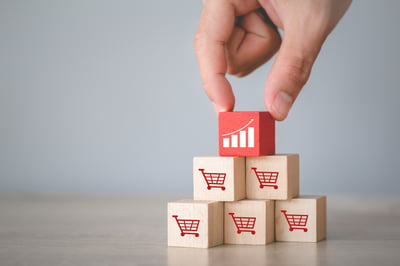October 26, 2023
 by Mads Fosselius / October 26, 2023
by Mads Fosselius / October 26, 2023

In many circumstances, companies are debating whether to focus on a sales-led or product-led approach for their new customer acquisition strategy.
Customer-led buying is in a position to combine elements from both of them to provide a new angle that places the customer at the core of the process.
When the customer has access to both advisory support and resources throughout the purchasing process, brands can increase the likelihood of a sale by providing a positive buying experience.
Ensuring that the customer’s needs are always kept as the core focus is the primary goal of the customer-led buying approach, and it does this by handling a balance of sales-led and product-led strategies. When successful, it allows brands to foster a sustainable model for long-term growth.
Recent market, geographic, and economic developments have made it clear that there is no standard approach to sales in the SaaS market. A one-size-fits-all approach simply doesn’t exist.
Current customer buying behaviors suggest that customers continue to increase their ability to purchase software with confidence and experience. Customers do not require as much guidance and handholding support as they used to in the past.
On top of this, the software providers continue to innovate products that are more intuitive to use and easy to sell for their sales teams as the need for IT dependence decreases in customers.
Taking this into account, the SaaS industry is seeing a trend in which vendors can expand their customer loyalty base by prioritizing a flexible and continuous review of their customers' buying experience based on their specific preferences.
The customer-led buying approach allows customers to value the experience, product, and time spent during their bespoke buying journey (which also impacts their post-signature experience).
To positively impact the buying journey, vendors need to allow their buyers to review the products in their own time and under their own environment or terms. This enables buyers to make decisions based on their preferences and shows buyers that the vendors prioritize customer experience.
Being proactive in providing a test environment to buyers can be a very effective way to create an efficient buying experience. It does this because it makes buyers feel more empowered when it comes to the decision-making process.
Customer-led buying can be effective because it enables freedom, control, and convenience for customers during their buying process. This doesn’t mean sellers must provide maximum freedom, but finding the optimum balance can generate comfortable and confident buyers.
This is even more important regarding SaaS products, which are collaborative and multi-user tools. Giving buyers the ability to use, test, and interact with the product with their peers increases their ability to get internal stakeholder buy-in.
Instead of just relying on a few members to decide on a new tool for the company or team, a customer-led buying model allows buyers to evaluate and get comfortable with the potential product.
Sharing the product experience with other stakeholders allows the main buyer to collect feedback and questions relevant to the purchasing decision.
This is, however, more than just providing a free trial. This has to go a level deeper because buyers need to see the product in action to get a better feel for the use cases and actions. Providing a pre-populated environment that can be immediately tested will significantly save the buyer and vendor time.
Buyers are frequently given access to a free trial or sandbox environment with nothing inside, forcing them to set up use cases to see what certain features and functionalities actually do.
If sellers more readily provide their product in a ready-to-go state with populated data, it will likely lead to a more informed and comfortable buyer who can effectively evaluate your products with questions, feedback, and product experience.
While the above has mainly been reviewing the buyer's benefits, it is clear that the vendor will also cut costs, save time, and have better qualification processes. A customer-led buying model and pre-populated product environments can save countless hours of repetitive calls, demos, and workshops with buyers.
While the highly valuable opportunities may receive special treatment, plenty of other customers should not be neglected when it comes to getting experience and exposure to potential products they are looking to purchase.
In the SaaS industry, buyers commonly compare multiple products before making a final purchase decision. An extensive amount of call scheduling and time is required for a buyer to experience multiple potential products. Providing buyers with the ready-to-test product in their own time correlates well with a less negative buying experience.
Read more: 2023 G2 Software Buyer Behavior Report →
Depending on the current setup of your organization, it’s critical to have alignment from the respective product, sales, finance, success, and marketing teams. Without most of these departments on board, shifting to a customer-led buying model will be difficult.
If your organization is adopting a customer-led buying model, similar strategies should be set for when the customers sign onto the rest of the journey post-signature.
Reiterating what was mentioned before, there is no one-size-fits-all approach to sales, so even with a customer-led buying model, not all your customers want to be treated the same way. Customer-led buying provides flexibility in the different potential buying experiences that vendors may come across.
Before reviewing the next four points for developing a customer-led buying strategy, ensure that you have conducted sufficient research into understanding your ideal customer profile, buying champion, and economic champion (budget holder and signer). This is important when segmenting your audience and scoping your strategy.
Where possible, spend time to ready your product so that your users can test it in their own time and see it in action. Avoid providing empty sandboxes, which require users to set up and imagine what the product might feel like for specific use cases.
Populating your product with data in a testing environment is an ideal way to get your users to test, ask, experience, and build confidence in their purchasing decisions.
Additionally, offering this to users even before they speak to a sales representative can also be advantageous because it increases product exposure to potential buyers without them needing to schedule and spend time in a classic sales cycle.
It's vital to provide your buyers with a personalized buying journey and experience that allows them to feel in control of the process. This can be done in a variety of ways but could include offering tailored environments, access to your product in their own time, and access to a representative who can answer their questions when they want extra guidance.
If buyers want to spend hours with their colleagues on your product before advancing to the next stage, let them. When they do have questions after testing your product, be available or be proactive in providing support when they want it.
Some buyers might want heavy guidance from a sales rep, while others might want maximum product exposure in their own time.
The customer-led buying approach allows the relationship to be hybrid and adapt to the different and varying needs of buyers in the SaaS market. Throughout the product and onboarding experience, there are many opportunities to personalize the buying experience between the buyer and seller.
Acting more as an ally in their buying journey allows buyers to build enduring relationships with customers pre- and post-signature. Don’t offer a standard free trial that fits all potential buyers; tailor it so it’s more relevant to the buyer.
It’s vital for buyers to invest in the business case, value, brand, and relationship in the buying process because it impacts the longevity of that relationship from signature, onboarding, renewals, advocacy, and expansion.
Tip: The closer you are to your customers as an ally, the easier it is to spot opportunities to work more closely with one another for maximum value.
It is important to remember that the commitment to a customer-led buying experience must also be replicated in the post-sales experience.
It is commonly disappointing when buyers are treated as VIPs in the buying process, but once the sale has been completed, the onboarding and management process is wildly different.
To execute an effective customer-led growth model, the customer must remain at the forefront of all the customer stages. The longevity of SaaS relationships occurs through a consistent customer-led experience, regardless of whether it is in the buying, onboarding, renewal, support, or expansion phases.
With the classic sales-led buying, the market is seeing it become less effective over time. Your typical buyer these days wants more control over the buying process of software but is also more cautious.
On top of being more cautious, they continue to become more tech-savvy than previous generations. The combination of this results in buyers being able to more easily see through standard sales processes, decreasing the chance they are pursued easily and increasing their ability to challenge vendors.
As an alternative, product-led buying has gained a lot of popularity. Users can quickly try a product and purchase it when they are ready. Buyers in this setup benefit as they have complete control of the buying process, are not bothered by salespeople, and don’t need to schedule demos to get a feel for the product they want to purchase.
A downside, however, is that while it can demonstrate a product’s features, it cannot always showcase the unique value of a product with a live-action experience or guidance of an experienced user.
Relying only on this approach can lead to decreased profitability, as an empty sandbox and free trial environments can prove challenging to showcase a product's unique value, making it difficult to convert users into paying customers.
Therefore, with the product and sales-led buying approaches having their constraints, the new and hybrid approach is customer-led, which gives customers the best of both worlds to create the ideal setup for the buying journey in today’s SaaS environment.
Organizations looking to adopt a customer-led buying model should construct pre-populated product environments, templates, and guided walkthroughs that resemble their product experience for the buyers.
Offering these experiences to buyers on their own terms empowers them to select the buying path that fits them best, which can help optimize the selling strategy.
Fostering a customer-led buying model for your sales department can generate more positive and long-lasting relationships not just during the buying process but also after they have officially signed on a customer. They will be able to onboard your product quicker, with greater confidence, and likely act as a promoter of your product due to the positive buying experience.
This is why vendors must build trust and loyalty by handing over more control to buyers in the selling process. This can be the foundation of a mutually beneficial relationship that impacts overall customer, company, and product growth.
Customer-led buying models can increase CSAT, reduce costs, boost sales, and impact key metrics such as increased share of wallet, higher close rates, and shorter sales cycles. Depending on how the buyer wants to test, share, validate, and purchase software, vendors can improve the overall buyer-seller experience and strategy.
To conclude, while this article has primarily focused on how a customer-led model can impact sales in the buying process, there are numerous benefits to which a customer-led approach can impact expansion, marketing, community, renewals, and products in the post-signature experience.
Learn more about the top four B2B software buyer behavior trends in 2023.
For 20+ years, Mads has had a singular focus to drive, revive, and accelerate change in the customer service space. By transforming contact centers' functions and empowering customer service agents, Mads has successfully enriched the agent and customer service experience across key global markets.
Product-led growth (PLG) is a go-to-market strategy that centers on the product.
 by Ioana Sima
by Ioana Sima
Product-led growth (PLG) has become one of the most important and pervasive topics in SaaS.
 by Bryan Belanger
by Bryan Belanger
Each and every company today aspires for efficient growth.
 by Marcin Stoll
by Marcin Stoll
Product-led growth (PLG) is a go-to-market strategy that centers on the product.
 by Ioana Sima
by Ioana Sima
Product-led growth (PLG) has become one of the most important and pervasive topics in SaaS.
 by Bryan Belanger
by Bryan Belanger


